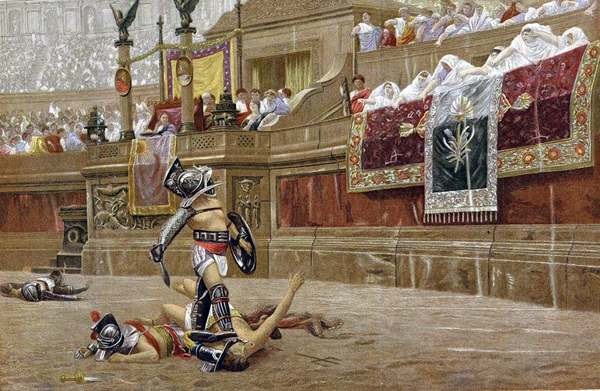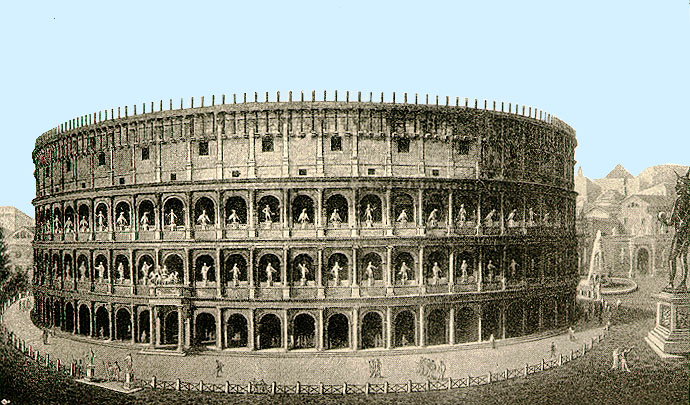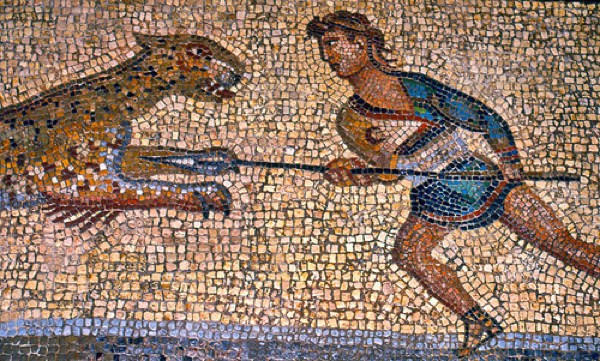Myths of the gladiators: Through Eternity tours sets the record straight

When I lived in Rome the first time, from 2001-03, I worked as a freelance travel writer and once gave myself an assignment that just wrote itself: gladiator school. I spent two months in a school training twice a week, doing highly choreographed fight scenes we later performed for tourists and locals around Rome. In the colosseum in suburban Sutri, I pretended to die in front of about 1,000 people — while prone on the ground trying to pull my one-size-fits-all tunic over my underwear.
I also learned a lot about gladiators from books, particularly Daniel Mannix’s excellent 1958 tome, “The Way of the Gladiator.” However, I learned even more from Through Eternity’s Colosseum, Forum and Palatine Hill tour. Over five hours, it started with tours of the Roman Forum and Palatine Hill. At the final stop at the Colosseum, tour guide Gracelyn Monaco blew away a lot of myths people have about the famed gladiators. Forget what you saw in the movie “Gladiator.” It was accurate but didn’t tell the whole story.
It wasn’t nearly as violent as the real thing.

In December I started a new part-time job blogging for Through Eternity. As I told friends in Rome and friends who have visited Rome, I learned Through Eternity (www.ThroughEternity.com, office@througheternity.com, 1-800-267-7581, 39-06-700-9336) is arguably the most respected tour company in the city. Rob Allyn, an American from Connecticut, started it in 1999 and it has been going strong ever since. I have never been a big tour guide person, but I will say the two tours I’ve taken and blogged about have been among the best I’ve had anywhere in the world.

After three years in Rome, I learned a lot, especially about gladiators. The gladiator games in the Colosseum had a lot of myths. Here are some of them:
TICKETS WERE SOLD TO THE GLADIATOR GAMES. Ancient Rome was rich but most Romans were poor. In fact, Gracelyn said one in four was a slave. “How do you make sure people don’t revolt?” she asked. “You feed them. They had as much water as they wanted. They could go to the baths. They had free circus, horse races, they had free theater. It’s a shell game. You trick them into not realizing that they’re not poor. If you’re fed and you’re entertained — ‘bread and circuses’ — then people won’t revolt against you.” The most extravagant entertainment were gladiator games. And they were free. Romans would go to an open space such as the Forum and receive a free ticket, usually carved in bone or terracotta. It would have the numbers of the Colosseum arch they’d walk through and the level where they’d sit, all according to class. The games were sponsored by an “editor,” who was usually the reigning emperor. The senators and emperors who put on the games knew that “the more fantastic the games, the more they’ll love you,” Gracelyn said. They even held raffles where fans would get wooden balls with a gift written on them. It could be an apartment or money or animal meat from the beasts they watched die that day. Often the games featured wrestling matches in the stands from people fighting over the balls.
THE GAMES WERE ONLY ABOUT GLADIATORS
ALL GLADIATORS WERE UNDEFEATED. Again, not true. Some monuments to gladiators list their win-loss record. One reads 10-3. Huh? Gracelyn explained that many of the most popular gladiators were stars. They received food, doctors, massages, sometimes money. They were also worth a lot of money to their owners. If they were defeated, on the ground and helpless, the winning gladiator looked for the signal to kill. The crowd often said no, just so they could see him fight again.
The thumbs down indicated “to kill.” Think about an emperor’s thumb pointing down. How many gladiators can actually see the thumb from clear across the arena? He’d better be right or he’ll kill a man by mistake. In Ancient Rome, what’s believed occurred is the motion of a thumb going down represented the sheathing of the sword. The motion to kill was the raised thumb moving across the throat, a motion still used today by anyone angry enough. What sometimes happened is the crowd would yell “YOO-GHEE-LA! YOO-GHEE-LA! (JUGULAR! JUGULAR!). That’s when the winner cut his throat.
GLADIATORS TRAINED WITH WEAPONS. The publicity leading to the games was massive. They couldn’t afford to advertise a famous gladiator appearing and he gets his hand sliced off the week before. Thus, they all trained with wooden weapons. Also, the organizers were afraid of gladiators killing themselves before appearing in the Colosseum. “They’d rather kill themselves with dignity than let themselves be entertainment for the Romans,” Gracelyn said.
THE COLOSSEUM HELD NAVAL BATTLES. It wasn’t possible. The Colosseum wasn’t big enough. Mock naval battles were held around Rome but part of the show was sinking enemy boats. At most, the Colosseum could hold three or four feet of water. The only boats they could sink were miniature or maybe took place during the opening celebrations. Once the substructure was built to hold the animals and gladiators below the Colosseum floor, it couldn’t be flooded.
THE COLOSSEUM WAS ABANDONED WITH THE GLADIATOR GAMES ENDED. The last documented animal games were in 523 but the Colosseum was used long after the Roman Empire fell. As everyone from the Goths to the Vandals sacked Rome, poverty in the city mounted. By the Middle Ages, squatters had set up residence inside the amphitheater. In the 12th century, it housed fortresses. Yes, the powerful Frangipane family moved its cavalry inside. In the 16th century, Pope Sixtus V planned a wool factory that never came to fruition. Later, even botanists found use for the Colosseum. So much plant life (read: weeds) had taken root that an Italian botanist in the 17th century found 300 different species of flora. In the 19th century, a British botanist wrote a book popular during the Grand Tour entitled, “The Flora of the Colosseum.”
Maybe it’s because I was a sportswriter for 40 years, but the Colosseum has always been my favorite monument in Rome. However, it’s important to put it in the perspective of life in Ancient Rome. Our five-hour Through Eternity tour did just that. We first went through the Roman Forum where the masses worked, then we climbed up Palatine Hill where the aristocracy lived before we descended into the Colosseum to see where the masses and aristocracy were entertained. I got a good feel for the whole of the most powerful society in man’s history.
Then later, at night, I walked up behind Il Vittoriano, the massive chunk of white confection known as “Mussolini’s Typewriter.” I looked down at the Roman Forum, all back lit like a Caravaggio painting, and imagined how life could’ve been back then. Then just beyond, in the Colosseum, I thought I heard a gladiator roar.


August 9, 2017 @ 7:39 am
Fantastic post!
August 9, 2017 @ 9:20 am
Thanks. It’s really a worthy tour and I don’t do many tours.
August 9, 2017 @ 9:26 am
Thank you for sharing it with us!